
William Caslon I, also known as William Caslon the Elder, was an English typefounder. The distinction and legibility of his type secured him the patronage of the leading printers of the day in England and on the continent. His typefaces transformed English type design and first established an English national typographic style.
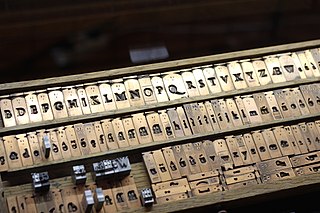
In the manufacture of metal type used in letterpress printing, a matrix is the mould used to cast a letter, known as a sort. Matrices for printing types were made of copper.

Monotype Imaging Holdings Inc., founded as Lanston Monotype Machine Company in 1887 in Philadelphia by Tolbert Lanston, is an American company that specializes in digital typesetting and typeface design for use with consumer electronics devices. Incorporated in Delaware and headquartered in Woburn, Massachusetts, the company has been responsible for many developments in printing technology—in particular the Monotype machine, which was a fully mechanical hotmetal typesetter, that produced texts automatically, all single type. Monotype was involved in the design and production of many typefaces in the 20th century. Monotype developed many of the most widely used typeface designs, including Times New Roman, Gill Sans, Arial, Bembo and Albertus.
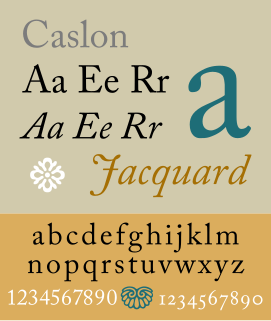
Caslon is the name given to serif typefaces designed by William Caslon I (c. 1692–1766) in London, or inspired by his work.

Punchcutting is a craft used in traditional typography to cut letter punches in steel as the first stage of making metal type. Steel punches in the shape of the letter would be used to stamp matrices into copper, which were locked into a mould shape to cast type. Cutting punches and casting type was the first step of traditional typesetting. The cutting of letter punches was a highly skilled craft requiring much patience and practice. Often the designer of the type would not be personally involved in the cutting.

Stephenson Blake is an engineering company based in Sheffield, England. The company was active from the early 19th century as a type founder, remaining until the 1990s as the last active type foundry in Britain, since when it has diversified into specialist engineering.
Richard Austin (1756–1832) was an English punchcutter. He was the original cutter of the typefaces now known as Bell, Scotch Roman, and Porson. Born in London 4 August 1756 and christened at St Luke's Old Street, he studied seal, die and copper-plate engraving as an apprentice to John Phillips near Finsbury Square. He married Phillips' daughter Sarah and set up on his own about 1786. He was hired by John Bell's British Letter Foundry in 1788 as a punch-cutter, to imitate Didot's 1782 types "de la troisième manière," cut by Pierre Vafflard to F-A Didot's designs. Bell sold his interest in the foundry to S & C Stephenson. When the foundry closed in 1797, Austin brought in his own punches and sold strikes to Fry & Steele, Figgins, and Caslon. Strikes were even sold in North America. Austin cut Greek types for Cambridge University Press in 1806–8, following designs provided by the famous master Richard Porson. He probably also cut the Sarcophagus Greek that preceded it. Austin then provided strikes to William Miller's foundry in Edinburgh & Alexander Wilson's Sons' foundry in Glasgow, creating the types now known as Scotch, before founding his own Imperial Letter Foundry in London in 1815, with his son George. The first Miller Specimen of 1809 is now lost. Wilson's earliest specimen showing the improved types is dated 1812. Richard Austin died circa 20 August 1832, leaving the foundry to his son George, whom many credited with the innovations in type designs manifest in the Scotch types. Austin's other sons were John Phillips Austin, a music engraver, and Richard Turner Austin (1781-1842), a painter and commercial wood engraver.
The Bauer Type Foundry was a German type foundry founded in 1837 by Johann Christian Bauer in Frankfurt am Main. Noted typeface designers, among them Lucian Bernhard, Konrad Friedrich Bauer, Walter Baum, Heinrich Jost, Imre Reiner, Friedrich Hermann Ernst Schneidler, Emil Rudolf Weiß, and Heinrich Wienyck, designed typefaces for the company.
Robert Wiebking (1870–1927) was a German-American engraver typeface designer who was known for cutting type matrices for Frederic Goudy from 1911 to 1926.

The Intertype Corporation produced the Intertype, a typecasting machine closely resembling the Linotype, and using the same matrices as the Linotype. It was founded in New York in 1911 by Hermann Ridder, of Ridder Publications, as the International Typesetting Machine Company, but purchased by a syndicate for $1,650,000 in 1916 and reorganized as the Intertype Corporation.
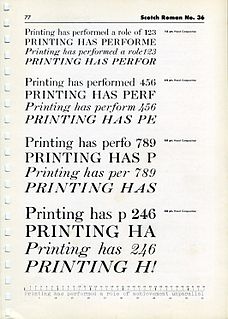
Scotch Roman is a class of typefaces popular in the early nineteenth century, particularly in the United States and to a lesser extent the United Kingdom. These typefaces were modeled on a design known as Pica No. 2 from the Edinburgh foundry of William Miller. Some accounts suggest that Miller's type, the oldest surviving specimen of which dates to 1813, was cut by Richard Austin, who had previously produced the Bell types for the British Letter Foundry.

Vincent Figgins was a British typefounder based in London, who cast and sold metal type for printing. After an apprenticeship with typefounder Joseph Jackson, he established his own type foundry in 1792. His company was extremely successful and, with its range of modern serif faces and display typefaces, had a strong influence on the styles of British printing in the nineteenth century.
Fundición Tipográfica Neufville or the Neufville Typefoundry is a type foundry in Barcelona and the most important supplier of the printing industry in Spain during the 20th century.
James Mosley is a retired librarian and historian whose work has specialised in the history of printing and letter design.

A display typeface is a typeface that is intended for use at large sizes for headings, rather than for extended passages of body text.
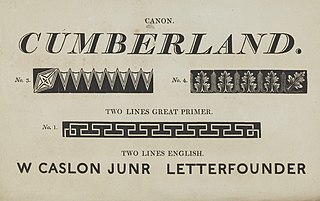
The Two Lines English Egyptian typeface is a font created by the Caslon foundry of Salisbury Square, London around or probably slightly before 1816, that is the first general-purpose sans-serif typeface in the Latin alphabet known to have been created.

Anthony Bessemer was a British industrialist and punchcutter, who spent large portions of his life in the Netherlands and France before returning to live in London and Hertfordshire. His son was Sir Henry Bessemer, the inventor of the Bessemer process for steel manufacture.

In typography, a fat face letterform is a serif typeface or piece of lettering in the Didone or modern style with an extremely bold design. Fat face typefaces appeared in London around 1805-10 and became widely popular; John Lewis describes the fat face as "the first real display typeface."
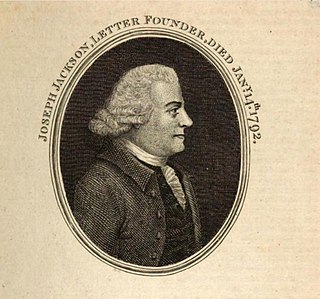
Joseph Jackson was a British engraver and typefounder who cut, cast and sold metal type. His foundry was based at Salisbury Square in London. He employed Vincent Figgins as an apprentice. He was in poor health towards the end of his life, but left a considerable fortune. He was also deacon of the Church of Christ, Barbican. He married first Elizabeth and then Mary. As he was childless, on his death, his estate mostly left to his fourteen nephews and nieces and his type foundry was taken over by William Caslon III. He was buried at Spa Fields Chapel; a sermon was preached on his death by John Towers. His tombstone described him as "a truly honest man and a good Christian...universally respected".

The Caslon type foundry was a type foundry in London which cast and sold metal type. It was founded by the punchcutter and typefounder William Caslon I, probably in 1720. For most of its history it was based at Chiswell Street, Islington, was the oldest type foundry in London, and the most prestigious.














